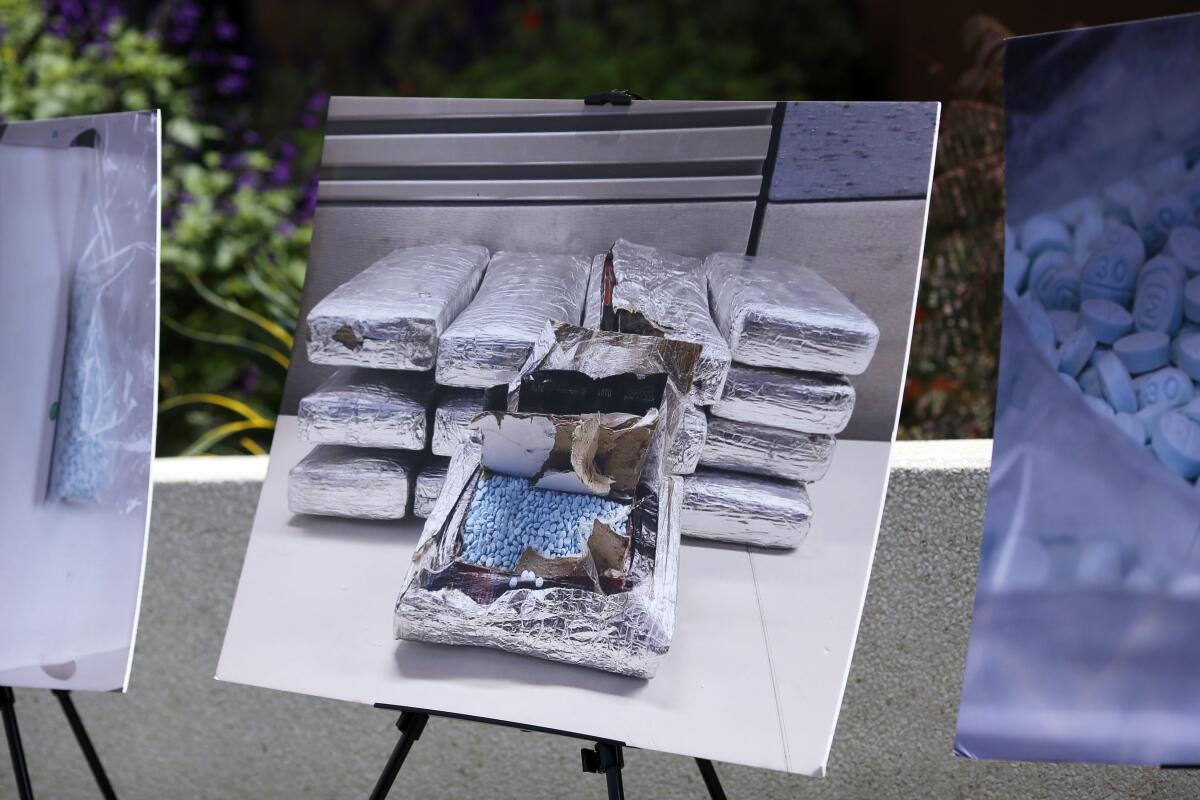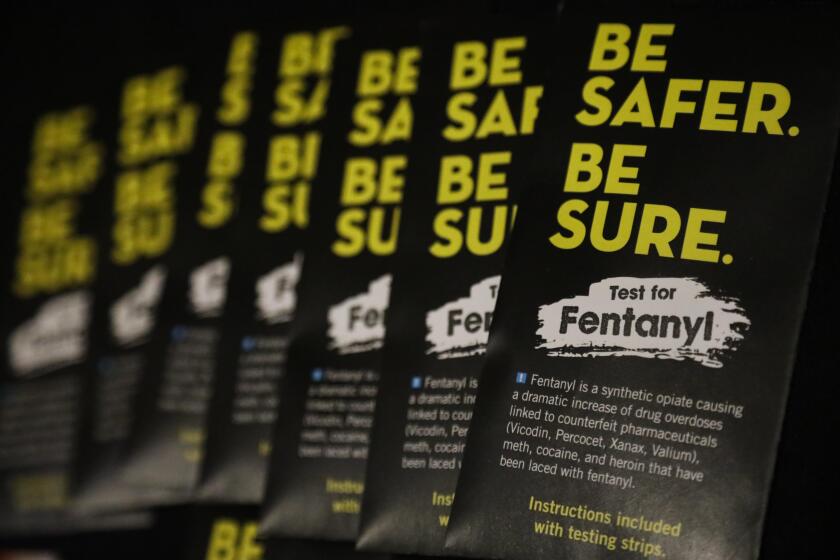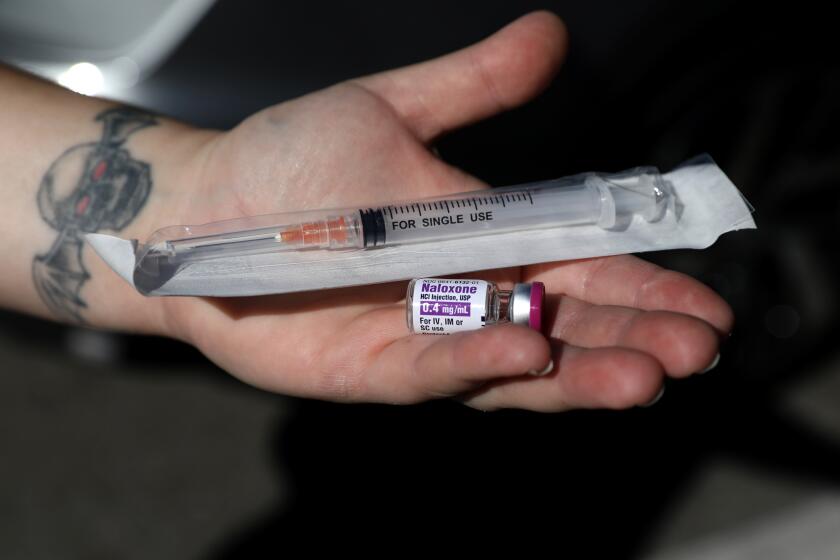L.A. County raises alarm about mysterious blue pills after three girls nearly die

- Share via
A bag of mysterious, deadly blue pills has prompted health and school officials to raise a countywide alarm this week after three 16-year-olds crushed a few, snorted them and nearly died — a dangerous development amid a pandemic-related rise in drug overdoses.
The incident happened May 25 in Los Angeles County and involved teens who thought they were buying the drug ecstasy. One girl suffered a brain injury that resulted in her temporarily losing the ability to breathe on her own and a second girl tested as having potentially serious damage to her heart.
The lethal pills have entered the L.A. marketplace during an especially dangerous time, when opioid use has been on the rise, along with drug overdose deaths.
Provisional data from the National Center for Health Statistics tabulated 100,306 drug overdose deaths in the United States during the 12-month period ending in April 2021, an increase of 28.5% from the 78,056 deaths during the same period the year before.
In 2021, fentanyl — a likely culprit in the blue pills — was identified in about 77% of adolescent overdose deaths nationally, the county alert stated. The alert also cited data from 2015 that 80% of drug overdose deaths among adolescents aged 15 to 19 in 2015 were unintentional, meaning that the teens were trying to get a buzz, not trying to kill themselves.
Local data suggest a connection in timing to the pandemic. A county report compared overdose deaths from March through December of 2020 — early in the COVID-19 pandemic — to an analogous period before the pandemic, from March through December of 2019.
Fentanyl is often mixed with other drugs (including heroin, methamphetamine and cocaine) to increase potency, but it can be deadly. Test kits can help.
“There is a clear and significant association between COVID-19 and the substantial uptick in drug overdose deaths during this specific time period,” according to a July 2021 county health department report.
The data show that before the pandemic, overdose deaths already were alarmingly on the rise, increasing from 777 in 2010 to 1,204 by 2018 to 1,652 in 2019. Then schools closed and communities began lockdowns in March 2020. Overdose deaths spiked to 2,425 in 2020.
Overdose deaths started off higher and increased faster in higher poverty areas, but there were sharp increases in all areas, regardless of income or geography.
Children were affected as well. The 10-month comparisons revealed an increase from four to eight in overdose deaths among children ages 11 and under. For ages 12 to 17, the deaths rose from nine to 27.
The three girls who snorted the blue pills, who have not been identified to protect their privacy, survived because a parent discovered them and a medical team acted quickly. The teens were brought back by naloxone, a drug that can reverse opioid overdoses. But they were not well.
The state and L.A. County have worked hard to make Naloxone more widely available. One of the hurdles, though, has been the price of the inhalable version, Narcan.
The girl with the brain injury “had problems breathing on her own. She had rigidity, difficulty walking, difficulty swallowing as well,” said Dr. Siddarth Puri, associate medical director of prevention with the county health department.
“I don’t know to what extent the damage is going to be permanent or not,” said Dr. Brian Hurley, medical director for substance abuse prevention and control at county health. “It remains to be seen.”
As of Thursday, one of the three girls had been released from the hospital. The remaining two are breathing on their own and eating. One girl continues to have “neurological complications,” but is slowly improving, Puri said.
In the hospital, the girls tested positive for cannabis and fentanyl, but not for methamphetamine or amphetamine — drugs also commonly linked to overdose deaths. Other test results, including for ecstasy, could take another week or two to get back. Hurley said that fentanyl is not commonly associated with cannabis, making the blue pills the most likely suspect.
Fentanyl is a synthetic opioid that is up to 50 times stronger than heroin and 100 times stronger than morphine, according to the U.S. Centers for Disease Control and Prevention.
“It is often added to other drugs because of its extreme potency, which makes drugs cheaper, more powerful, more addictive and more dangerous,” the federal agency warns.
Puri said it’s difficult to trace where the fentanyl came from.
“We know there are a lot of illicit substances coming up through Mexico, and fentanyl from China and India,” but it’s “impossible for us to know its origin,” he said.
The three girls lost consciousness after ingesting the pills, which they shopped for online. Shortly after their inquiry, the individual who showed up at the door gave them their order and had many more pills in hand, Hurley said.
“The story was that the youths that purchased these pills, purchased them from somebody with a large bag,” Hurley said. “So when we put this warning out, the intention was really for hospitals to keep an eye out for other overdoses involving purported ecstasy but which had other contaminants.”
Ecstasy, which is historically associated with raves and partying, has potential risks as well, but nothing on the order of fentanyl, Hurley said.
The three girls could provide no leftover blue pills to examine. But “if somebody comes by with a big bag of ecstasy, we want people to understand that there are more significant risks than they might have otherwise expected,” Hurley said. “The black-market pills could contain fentanyl and other contaminants that can cause death.”
As word of the warning got around, school district officials, including the medical director of the L.A. Unified School District, passed along the alert to parents.
“We encourage you to have discussions with your child about making healthy choices and about the dangers of ingesting any illicit drugs,” Dr. Smita Malhotra wrote in a letter to parents, “especially as we enter into end-of-year celebrations and the summer.”
More to Read
Sign up for Essential California
The most important California stories and recommendations in your inbox every morning.
You may occasionally receive promotional content from the Los Angeles Times.

















